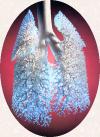| Effects of Subchronic Exposure to Wood Smoke on the Respiratory Tract of Rats |
|
Principal Investigator:
Johannes Tesfaigzi Co-Investigators: Edward B. Barr, Carole A.Conn, Fletcher F.Hahn |

Background: Wood smoke is a complex, particle-containing mixture that is associated with a number of respiratory illnesses in humans. It is an important seasonal environmental air contaminant in several locations in the U.S. where wildfires occur and where wood is burned in homes. There is a very small toxicological database on subchronic, repeated exposures to wood smoke, and less on chronic toxicity. This project will provide information on the respiratory health impacts of inhaled smoke from wood of the predominant type used in a New Mexico Native American community in which the incidence of childhood asthma is unusually high. This project will also provide experience in wood smoke exposure methodology and biological responses necessary for planning the core research matrix using wood smoke. Methods: This project is evaluating the inhalation toxicity of smoke from a wood stove using rats exposed for 30 or 90 days. The wood (juniper) and type of stove were selected to simulate exposure conditions in homes of a specific New Mexico Native American population in which a high incidence of childhood asthma may be associated with wood fuel use. This population is under study by the University of New Mexico, and information from this pilot toxicology study will enhance the University's work. The exposure levels were based on measurements in the homes (highest level = 2000 mg/m3) and the results from a preliminary experiment. The health response indicators include changes in BALF, T-lymphocyte proliferation, histopathology, and respiratory function. Status of the Project: A preliminary experiment was conducted to explore the range of particle concentrations producing biological effects, as an aid to selecting the exposures for the main pilot study. Rats were exposed to filtered air or to wood smoke at 2 and 20 mg/m3 for 3 hours/day for 5 days. The low concentration was the highest concentration measured in homes of population of concern, and the concentration was set at 10-fold the low level. To standardize the wood burning, the fire was started with 3 kg of wood using a propane torch and allowed to burn for 30 minutes before diverting smoke into the dilution/exposure system. Thereafter, 1 kg of wood was added to the fire every 13 minutes. The exposure concentrations were measured by weighing filter samples and had an means of 0, 2.1 (SD 0.948), and 20.5 (SD. 3.407) mg/m3. The BALF of the exposed rats was analyzed for lactate dehydrogenase (LDH), total protein, and b-glucuronidase. The total protein and LDH levels were significantly (p<0.05) elevated at the high level compared to the control and low levels. No significant differences were observed in b-glucuronidase or the numbers of macophages, neutrophils, lymphocytes, or eosinophils in BALF. The portion of macrophages containing >10 particles was greater at the higher exposure level. Based on these preliminary results, 1 and 10 mg particles/m3 were chosen as the exposure concentrations the main pilot study involving up to 90-day exposures. Micro Orifice Uniform Distribution Impactor (MOUDI) measurements showed that 86% of the particles in the exposure chambers were in submicron range. Smoke particles were collected at various times on quartz fiber filters and stored in baked glass containers at -80oC for detailed chemical analysis of particulate-phase organic chemicals by Phil Fine at Caltech. The composition of the exposure atmospheres during the 90-day exposure is summarized in Table 7. No differences were observed in body weight between groups. There were no exposure-related changes in BALF protein or LDH at 1 month. A difference was observed in the number of macrophages containing <10 and >10 particles. As expected, no air-exposed rats had carbonaceous particles in alveolar macrophages. About 50% and 7% of macrophages contained <10 particles, and about 13 and 75% contained >10 particles in rats exposed at 1 and 10 mg/m3, respectively (Figure 11).

Figure 11. Percentage of macrophages containing none, <10, or >10 carbonaceous particles after 1 month of exposure to air or to wood smoke at 1 or 10 mg particles/m3. The effects of the wood smoke on the immune system were investigated by analyzing the proliferation of T cells from the lung-associated lymph nodes and from spleen in response to concanavalin A (Con A). T cells from spleens of both the 1 and 10 mg/m3 rats had reduced incorporation of 3H-thymidine in response to activation with 0.3 and 1 mg/well of Con A. Similarly, T cells from lung-associated lymph nodes had reduced proliferation in response to Con A. These results indicate that not only the T cells associated with the lung, but also circulating T cells were affected by the wood smoke exposure. This may at least in part explain why respiratory tract infections are more common in populations using wood for cooking and heating. Pathological changes in the airway epithelia are being examined using nasal, tracheal, laryngeal, and lung tissues that have been processed and stained with hematoxylin and eosin or Alcian Blue and Periodic Acid Schiff. Respiratory function tests were being done on rats exposed for 90 days. Urine and blood samples were preserved at -80oC for future analyses of biomarkers for wood smoke exposure. |
|
e-mail: Webmaster or Librarians (800) 700-1016 ©1998 by Lovelace Respiratory Research Institute PO Box 5890, Albuquerque, New Mexico USA 87185-5890 all rights reserved |
